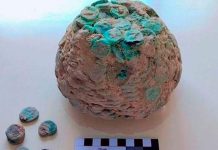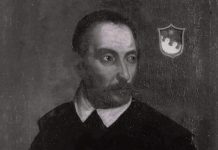Pontiac was an Ottawa chief. He was born on the Ottawa River in Canada in about 1720. While still a young man, he became the principal chief of the allied Ottawas, Ojibways, and Pottawatomies. He was always a firm ally of the French, to whose interests he was devotedly attached. He defended them in Detroit against an attack by the Northern tribes and (it is generally believed) led the Ottawas to Braddock’s defeat.
He reluctantly acquiesced to the French and Indian War. However, he was strongly disposed to dispute the progress of Major Rogers, the British officer sent to take possession of the western forts. In 1762, he dispatched emissaries to a large number of tribes, whom he urged to unite in a league for the extermination of the English. His proposals were favorably received, thus organizing what is commonly referred to as the “Conspiracy of Pontiac.”

He decided to attack Detroit. The garrison, however, was aware of his intention and prepared accordingly. Pontiac laid siege to the fort but could not prevent the ingress of provisions. The Canadian settlers furnished supplies to both besieged and besiegers with absolute impartiality. Finally, a boatload of ammunition and supplies landed at Detroit from Lake Erie, and the English made an unsuccessful sortie on July 31, 1763.
After a desultory battle that lasted nearly three months, the Indians withdrew into Indiana, where Pontiac tried to organize another movement. Although Detroit had not been taken, the Indians captured Forts Sandusky, St. Joseph, Miami, Ouiatanon, LeBoeuf, and Venango. In addition, they captured Mackinaw and Presque Isle. The garrisons at all these points were massacred, and innumerable outrages were perpetrated elsewhere.
Additional British troops were sent west, and the Indians were finally controlled. Pontiac was present at Oswego when a treaty was signed with Sir William Johnson, but remained implacable. His end was tragic. Broken in heart but still proud in spirit and relentless in purpose, he applied to the former (and last) French Governor of Illinois, the younger St. Ange, who was then at St. Louis, for cooperation and support in another raid against the British.
Being refused aid or countenance, according to a story long popularly received, he returned to Cahokia, where, in 1769, he was murdered by a Kaskaskia Indian for a barrel of liquor.
The N. Matson (author of several volumes bearing on early history in Illinois), citing Col. Joseph N. Bourassa, an educated half-breed of Kansas, as authority for his statement, asserts “that the Indian killed at Cahokia was an impostor and that the true Pontiac was assassinated by Kineboo.” The Head Chief of Illinois, in a council held on the Des Plaines River, near the present site of Joliet!
So convinced, it is said, was Pierre Chouteau, the St. Louis Indian trader, of this last story. He caused a monument erected over the false Pontiac’s grave to be removed. Out of the murder of Pontiac, whether occurring at Cahokia or Joliet, it is generally agreed that it resulted in the extermination of Illinois and the tragedy of “Starved Rock.”
Read More: Battle of Ox Hill, Chantilly







